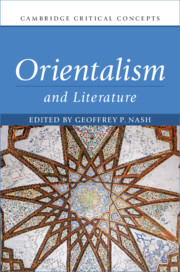Book contents
- Orientalism and Literature
- Cambridge Critical Concepts
- Orientalism and Literature
- Copyright page
- Contents
- Contributors
- Acknowledgments
- Introduction
- Part 1 Origins
- Chapter 1 Styles of Orientalism in the Eighteenth Century
- Chapter 2 The Origin and Development of the Oriental Tale
- Chapter 3 Romantic Orientalism and Occidentalism
- Chapter 4 The Victorians: Empire and the East
- Chapter 5 Orientalism and Victorian Fiction
- Chapter 6 Orientalism and Race: Aryans and Semites
- Chapter 7 Orientalism and the Bible
- Part II Development
- Part III Application
- Further Reading
- Index
Chapter 6 - Orientalism and Race: Aryans and Semites
from Part 1 - Origins
Published online by Cambridge University Press: 01 November 2019
- Orientalism and Literature
- Cambridge Critical Concepts
- Orientalism and Literature
- Copyright page
- Contents
- Contributors
- Acknowledgments
- Introduction
- Part 1 Origins
- Chapter 1 Styles of Orientalism in the Eighteenth Century
- Chapter 2 The Origin and Development of the Oriental Tale
- Chapter 3 Romantic Orientalism and Occidentalism
- Chapter 4 The Victorians: Empire and the East
- Chapter 5 Orientalism and Victorian Fiction
- Chapter 6 Orientalism and Race: Aryans and Semites
- Chapter 7 Orientalism and the Bible
- Part II Development
- Part III Application
- Further Reading
- Index
Summary
Aryanism pervades the Western intellectual tradition, emerging out of early modern understandings of human diversity and the engagement of European scholars with Asia, in particular Persia and then, centrally, India. While this engagement had an extensive prehistory, the definitive encounter took place within the context of colonialism, as part of a scholarly enterprise known, since Edward Said’s 1978 work, as Orientalism. Writing at the beginning of the twentieth century, Ernest Seillière defined “historical Aryanism,” exemplified by the work of Joseph-Arthur de Gobineau (1816–1882), as “a philosophy of history which attributes the moral and material advances of humanity more or less exclusively to the influence of the Aryan race.”1 In the interwar period, Frank Hankins glossed Aryanism as “historically the most influential doctrine of racial superiority” and included among its derivatives “Celticism in France, Teutonism in Germany and Anglo-Saxonism in England and America.” He noted presciently that Aryanism “metamorphoses, but it never dies.”2 Today, in the popular imaginary, Aryanism connotes above all Nazism and its vision of a superior “Aryan race,” as well as the white supremacism of the Aryan Brotherhood and similar far-right fringe groups.
- Type
- Chapter
- Information
- Orientalism and Literature , pp. 117 - 132Publisher: Cambridge University PressPrint publication year: 2019
- 1
- Cited by



